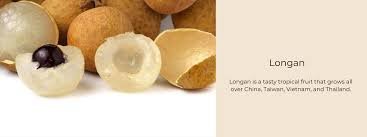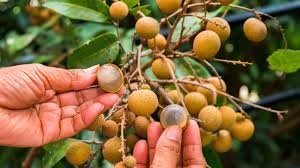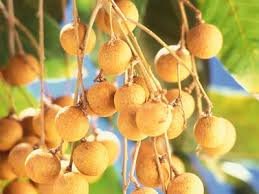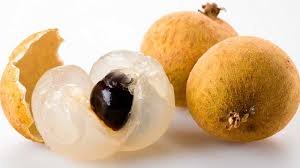Longan Tree (Dimocarpus longan)
I dream of growing rambutan and lychee in New Orleans and do know that Shu Shia had some lychee next to her house on the West Bank. I think if we can't get the two of those growing, how about the next best thing, their cousin, also from the East. Dimocarpus longan, commonly known as the longan and dragon's eye, is a tropical tree species that produces edible fruit. It is one of the better-known tropical members of the soapberry family Sapindaceae, to which the lychee and rambutan also belong.
The fruit of the longan is similar to that of the lychee, but less aromatic in taste. It is native to tropical Asia and China.The longan (from Cantonese lùhng-ngáahn 龍眼, literally means 'dragon eye'), is so named because it resembles an eyeball when its fruit is shelled (the black seed shows through the translucent flesh like a pupil and iris). The seed is small, round and hard, and of an enamel-like, lacquered black. The fully ripened, freshly harvested fruit has a bark-like shell, thin, and firm, making the fruit easy to peel by squeezing the pulp out as if one were "cracking" a sunflower seed. When the shell has more moisture content and is more tender, the fruit becomes less convenient to shell. The tenderness of the shell varies due to either premature harvest, variety, weather conditions or storage conditions.
These plants come from seeds started from fruit bought at Hong Kong Market on the West Bank. I advise everybody to buy a whole bag and plant all the seeds on a Southwest facing wall. I started about fifty seeds in a number of three gallon pots and used Mark Shephard's STUN theory (Ask me about it). These are the survivors, the ones most acclimated to our environment. Let's get longan growing everywhere.
I dream of growing rambutan and lychee in New Orleans and do know that Shu Shia had some lychee next to her house on the West Bank. I think if we can't get the two of those growing, how about the next best thing, their cousin, also from the East. Dimocarpus longan, commonly known as the longan and dragon's eye, is a tropical tree species that produces edible fruit. It is one of the better-known tropical members of the soapberry family Sapindaceae, to which the lychee and rambutan also belong.
The fruit of the longan is similar to that of the lychee, but less aromatic in taste. It is native to tropical Asia and China.The longan (from Cantonese lùhng-ngáahn 龍眼, literally means 'dragon eye'), is so named because it resembles an eyeball when its fruit is shelled (the black seed shows through the translucent flesh like a pupil and iris). The seed is small, round and hard, and of an enamel-like, lacquered black. The fully ripened, freshly harvested fruit has a bark-like shell, thin, and firm, making the fruit easy to peel by squeezing the pulp out as if one were "cracking" a sunflower seed. When the shell has more moisture content and is more tender, the fruit becomes less convenient to shell. The tenderness of the shell varies due to either premature harvest, variety, weather conditions or storage conditions.
These plants come from seeds started from fruit bought at Hong Kong Market on the West Bank. I advise everybody to buy a whole bag and plant all the seeds on a Southwest facing wall. I started about fifty seeds in a number of three gallon pots and used Mark Shephard's STUN theory (Ask me about it). These are the survivors, the ones most acclimated to our environment. Let's get longan growing everywhere.
I dream of growing rambutan and lychee in New Orleans and do know that Shu Shia had some lychee next to her house on the West Bank. I think if we can't get the two of those growing, how about the next best thing, their cousin, also from the East. Dimocarpus longan, commonly known as the longan and dragon's eye, is a tropical tree species that produces edible fruit. It is one of the better-known tropical members of the soapberry family Sapindaceae, to which the lychee and rambutan also belong.
The fruit of the longan is similar to that of the lychee, but less aromatic in taste. It is native to tropical Asia and China.The longan (from Cantonese lùhng-ngáahn 龍眼, literally means 'dragon eye'), is so named because it resembles an eyeball when its fruit is shelled (the black seed shows through the translucent flesh like a pupil and iris). The seed is small, round and hard, and of an enamel-like, lacquered black. The fully ripened, freshly harvested fruit has a bark-like shell, thin, and firm, making the fruit easy to peel by squeezing the pulp out as if one were "cracking" a sunflower seed. When the shell has more moisture content and is more tender, the fruit becomes less convenient to shell. The tenderness of the shell varies due to either premature harvest, variety, weather conditions or storage conditions.
These plants come from seeds started from fruit bought at Hong Kong Market on the West Bank. I advise everybody to buy a whole bag and plant all the seeds on a Southwest facing wall. I started about fifty seeds in a number of three gallon pots and used Mark Shephard's STUN theory (Ask me about it). These are the survivors, the ones most acclimated to our environment. Let's get longan growing everywhere.



